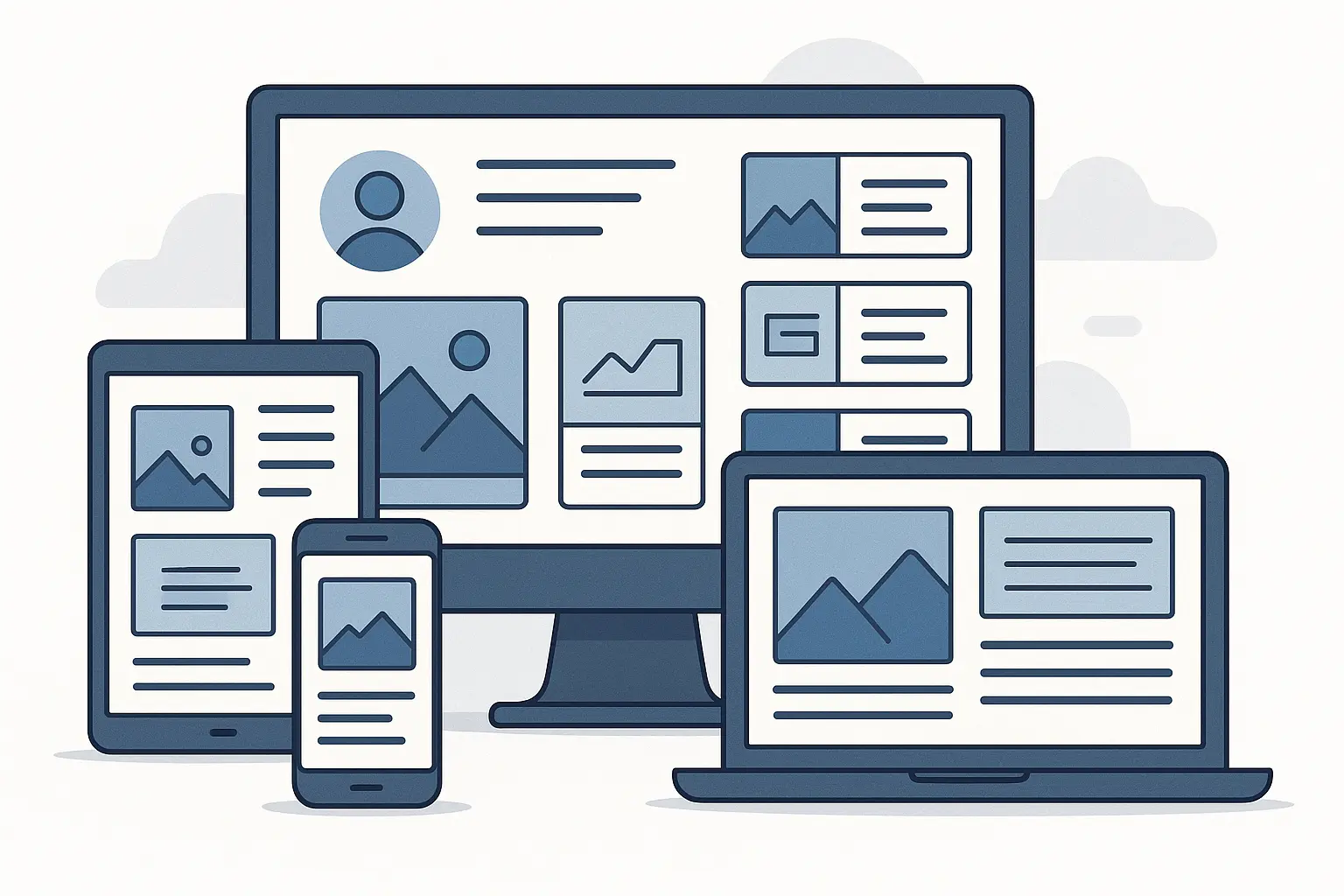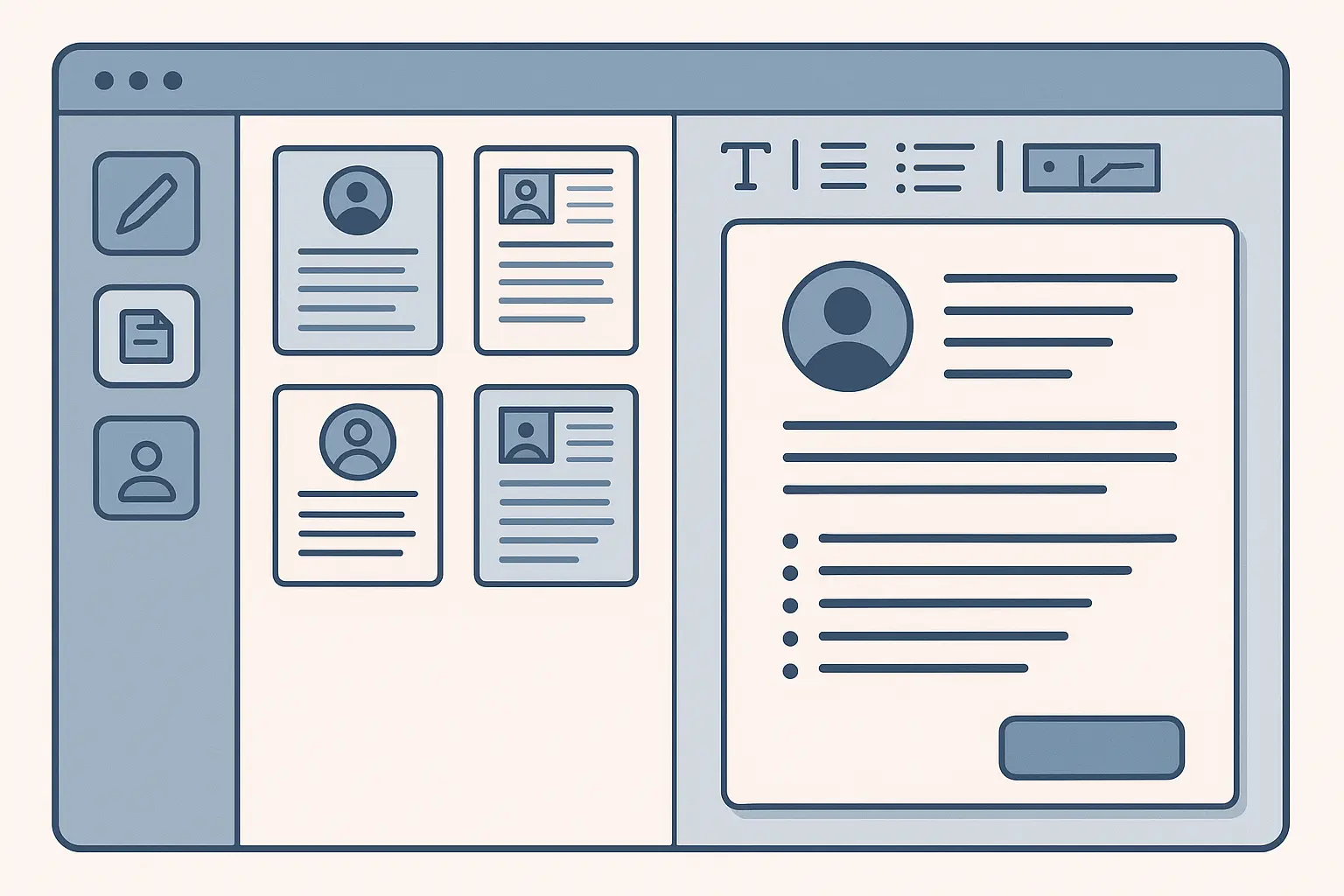Resume and Cover Letter Secrets That Actually Get You Hired (From Someone Who’s Been There)

Look, I’ve been where you are. Sending out dozens of applications and hearing nothing back. It’s soul-crushing. After years of trial and error (and way too many rejection emails), I finally figured out what actually works. This isn’t another generic “use action verbs” guide – it’s the real stuff that got me and my friends hired. With 94% of hiring managers finding cover letters influential when deciding who to interview, understanding both resume and cover letter strategies has never been more critical for job seekers.
Table of Contents
-
Resume Basics That Actually Work
-
Industry-Specific Strategies That Matter
-
Cover Letters That Don’t Suck
-
Using AI Without Looking Fake
-
Putting It All Together
The Quick Wins
-
Most resumes die in robot filters before humans see them – I’ll show you how to beat that
-
Your resume and cover letter should work together, not repeat each other
-
Numbers tell better stories than fancy words
-
Every industry plays by different rules
-
AI can help, but don’t let it write for you
-
Career gaps are normal – own them instead of hiding them
Resume Basics That Actually Work
Here’s the brutal truth: robots read your resume first. About 75% of resumes get rejected by software before any human even glances at them. But don’t panic – you can game this system without turning your resume into a boring keyword soup.
Beating the Robot Gatekeepers
These Applicant Tracking Systems (ATS) aren’t as smart as they seem. They’re looking for specific things, and once you know the rules, it’s actually pretty easy to play along. With ATS systems being employed by 98% of Fortune 500 companies to make hiring decisions, understanding this process is crucial for modern job seekers.
For those looking to ensure their documents pass these screening systems, our comprehensive ATS-friendly resume guide provides detailed strategies for optimizing your application materials.
Stick to boring section headers. I know “My Journey” sounds more creative than “Experience,” but the robots are looking for standard terms. Use “Experience,” “Education,” “Skills” – save your creativity for the content.
Keywords matter, but don’t stuff them everywhere. Pull 5-6 key terms from the job posting and weave them naturally into your descriptions. “Managed social media campaigns” becomes “Developed social media marketing strategies that increased engagement by 45%.”
Keep it simple with formatting. No fancy graphics, tables, or creative layouts. The robots can’t read that stuff, so all your hard work becomes invisible. Stick with clean, simple formatting that both robots and humans can handle.
File format matters. PDF keeps your formatting intact, but have a Word version ready just in case. Some older systems struggle with PDFs.
Making Humans Want to Keep Reading
Once you pass the robot test, you’ve got about 6 seconds to grab a human’s attention. Here’s how to make those seconds count.
Your summary needs to work harder. Forget those old “objective” statements – nobody cares what you want. Tell them what you can do for them in 3-4 lines. “Marketing professional with 5 years of experience” is weak. “Increased social media engagement by 200% and generated $500K in new revenue through targeted campaigns” hits different.
Numbers are your best friend. Instead of “responsible for customer service,” try “resolved 50+ customer issues daily with 98% satisfaction rating.” Instead of “managed a team,” say “led team of 8 that reduced processing time by 30%.”
Understanding the optimal length for your situation is crucial – our detailed resume length guide helps you determine when to stick to one page versus expanding to two.
Two pages max, usually. Unless you’re applying for academic or government roles, keep it tight. Force yourself to prioritize – if it doesn’t make you look amazing, cut it.
Design for mobile. Half of hiring managers check applications on their phones. If your resume looks like garbage on mobile, you’re toast.
Design That Actually Works
Your resume needs to look professional across all devices and situations. Simple, clean designs consistently outperform flashy alternatives.
Font choice seems minor but impacts readability significantly. Stick with Arial, Calibri, or similar sans-serif fonts that remain clear at different sizes and across various devices. Fancy fonts might look interesting but often cause formatting issues.
White space is your friend, not wasted space. Proper margins and spacing make information easier to process and prevent your resume from looking cluttered. Cramming more content into less space usually backfires.
Choosing the right visual elements is essential – our guide to the best resume fonts ensures your document maintains professional appeal while remaining readable across all devices.
|
Resume Section |
Recommended Length |
Key Purpose |
|---|---|---|
|
Professional Summary |
3-4 lines |
Establish immediate value proposition |
|
Work Experience |
3-5 bullet points per role |
Demonstrate quantified achievements |
|
Skills |
8-12 relevant skills |
Match job requirements |
|
Education |
1-2 lines |
Provide credential verification |
Industry-Specific Strategies That Matter
What works in tech will bomb in finance. What impresses startups might horrify corporate HR. Here’s the real talk on different industries.
Corporate and Business Roles
These folks love conservative, results-focused presentations. Think suits, not sneakers.
Traditional formatting wins. Clean layouts, standard fonts, conservative colors (if any). Show them you can fit into their buttoned-up world.
Metrics rule everything. Revenue generated, costs reduced, efficiency improvements – these numbers immediately show your impact level. “Increased sales by 40%” or “Reduced processing time by 25%” speaks their language.
Leadership matters, even if you weren’t the boss. Project coordination, cross-functional collaboration, training new hires – all of this shows you can handle responsibility.
Before: “Responsible for managing customer accounts and handling complaints”
After: “Managed portfolio of 150+ enterprise accounts worth $2.3M annually, achieving 94% customer retention rate and reducing complaint resolution time by 40% through implementation of streamlined support processes”
Creative and Design Industries
Here you can show some personality, but don’t go crazy.
Your resume IS part of your portfolio. It should look good and show your design sense, but readability comes first. Creative doesn’t mean confusing.
Portfolio links are non-negotiable. Make it easy to see your work. Include prominent links and mention specific projects that match what they’re looking for.
Software skills get detailed attention. List specific programs, versions, and skill levels. “Proficient in Adobe Creative Suite” is too vague. “Expert in Photoshop CC, Illustrator CC, and InDesign CC with 5+ years experience” tells the real story.
Creative achievements need context beyond just aesthetics. Awards are great, but explaining the business impact of creative work (increased engagement, improved conversion rates, successful campaign results) demonstrates strategic thinking alongside creative ability.
Tech and Engineering
Tech resumes need to balance technical depth with accessibility.
Organize your technical skills strategically. Group programming languages, frameworks, databases, and tools into clear categories. Include proficiency levels so both technical and non-technical reviewers can assess fit.
Explain both the technical challenge and business impact. “Built microservices architecture that reduced system downtime by 40%” tells a complete story that resonates with different audiences.
Show continuous learning. Recent certifications, courses, open source contributions, personal projects – tech moves fast, and employers need to see you’re keeping up.
Problem-solving examples resonate strongly in technical roles. Describing how you approached complex challenges, the solutions you developed, and the results achieved demonstrates the analytical thinking that tech employers value.
Cover Letters That Don’t Suck
Most cover letters are terrible. Generic, boring, completely forgettable. But when done right, they’re incredibly powerful for showing personality that resumes can’t capture. With 83% of hiring managers reading the majority of cover letters they receive, investing time in crafting compelling letters pays off significantly.
Understanding the fundamentals of effective cover letter writing is essential – our comprehensive guide on how to write a cover letter that gets noticed provides actionable strategies for creating compelling applications.
Opening Lines That Actually Work
Your first paragraph determines whether your cover letter gets read or trashed. “I am writing to apply for…” immediately signals this is another template letter.
Do your homework and show it. “Your recent expansion into the European market caught my attention, especially given my experience helping SaaS companies navigate international growth challenges.” This shows you’re paying attention to their world, not just blasting out generic applications.
Lead with your strongest qualification. Instead of building up to your best stuff, start with it. “As someone who increased social media engagement by 200% in my current role…” immediately establishes credibility.
Skip the generic enthusiasm. “I am excited to apply” means nothing because everyone says it. Instead, be specific about what excites you: “The opportunity to help [Company] expand into new markets aligns perfectly with my passion for growth strategy.”
Building Your Case with Stories
The body should feel like a conversation about how your experience directly addresses their needs. This isn’t about repeating your resume – it’s about providing context and showing your thinking process.
Match their key requirements. Pick 2-3 main things they’re looking for and address each one directly. If they need someone who can manage teams and increase efficiency, give specific examples of both.
Tell stories, not just facts. Instead of “I managed a team of 10,” explain the challenge your team faced, how you addressed it, and what results you achieved together. Stories are memorable; facts are forgettable.
Show your methodology. Employers want to understand how you approach problems, not just what results you’ve achieved. Walk them through your process so they can envision what you’d bring to their team.
Industry knowledge integration shows you understand the broader context. Referencing industry trends, common challenges, or emerging opportunities demonstrates that you’re thinking strategically about the role and company.
Customization That Shows You Actually Care
Generic cover letters are immediately obvious and usually ineffective. True customization goes beyond just changing the company name. The modern approach emphasizes brevity and personality, with “somewhere between 200 to 400 words being the modern sweet spot” according to current hiring trends.
Recent company news provides excellent conversation starters. When you mention a recent product launch, funding round, or market expansion in your opening, it shows you’re paying attention to what’s happening in their world right now.
Cultural alignment goes deeper than mission statements. Look at employee reviews, social media presence, and leadership interviews to understand what it’s really like working there. This helps you speak their language and demonstrate genuine fit.
Generic Opening: “I am writing to express my interest in the Marketing Manager position at your company.”
Research-Based Opening: “Your recent expansion into the European market caught my attention, particularly given my experience helping SaaS companies navigate international growth challenges. Having increased market penetration by 40% during similar expansions at two previous companies, I’m excited about the opportunity to contribute to [Company’s] ambitious global strategy.”
Endings That Create Action
Strong closings reinforce enthusiasm while making it easy for hiring managers to move forward.
Be specific about next steps. Instead of “I look forward to hearing from you,” try “I’d love to discuss how my experience scaling social media campaigns could help [Company] reach its growth targets. I’m available for a call this week and will follow up early next week.”
Make it easy to contact you. Even though your contact info is in the header, include it again in the closing. Remove any friction from the process.
Using AI Without Looking Fake
AI has completely changed how I approach resume writing. These tools can transform basic job descriptions into compelling achievement statements, but you need to use AI as a starting point, not a replacement for your authentic experience. With “over 50% of students believing utilizing AI tools on job applications would give some candidates an unfair advantage”, it’s important to use these tools ethically and authentically.
AI Tools That Actually Help
The biggest challenge most people face is translating everyday work into impressive-sounding achievements. AI excels at this, but you need to guide the process with real details.
Start with specifics. Don’t just tell AI “I answered customer emails.” Give it context: “I resolved 50+ customer inquiries daily with a 95% satisfaction rating, handling everything from billing issues to technical support.”
Use AI suggestions as a starting point. The tools might suggest generic achievement language, but you need to verify accuracy and add details that reflect your actual experience. Never use AI-generated content you can’t back up in an interview.
Let AI help with keyword integration. Copy job descriptions into AI tools and ask them to identify important keywords, then look for natural ways to incorporate this language into your experience descriptions.
The best AI tools ask follow-up questions to help you think through your accomplishments. They might prompt
you to consider cost savings, time improvements, quality enhancements, or team impact that you hadn’t initially thought to mention.
Smart Keyword Integration
Job posting analysis reveals the specific language employers use and value. But keyword density matters less than readability – you want to use language that resonates with employers while maintaining natural flow.
AI Prompt: “Help me rewrite this job responsibility: ‘Managed social media accounts for the company'”
AI-Enhanced Result: “Developed and executed social media strategy across 4 platforms, increasing follower engagement by 65% and generating 300+ qualified leads monthly through targeted content campaigns”
The AI helped structure and enhance the language, but the specific numbers and results came from real experience.
Synonym suggestions help avoid repetitive language while maintaining keyword relevance. If a job posting emphasizes “collaboration” but you’ve already used that term, AI tools can suggest alternatives such as “cross-functional teamwork” or “stakeholder coordination.”
Performance Tracking and Continuous Improvement
Modern job searching generates data that can guide strategic improvements to your application materials. Tracking which resume versions generate more responses helps optimize your approach over time.
Application-to-response ratios tell important stories about resume effectiveness. Track how many applications result in initial responses, phone screens, and in-person interviews. Significant changes in these ratios often indicate when resume updates are working.
A/B testing different resume versions provides concrete data about what resonates with employers. You might test different professional summary approaches or experience organization methods to see which generates better response rates.
Putting It All Together
Your resume and cover letter need to work as a team, telling a cohesive story about your professional brand while serving different purposes.
Making Everything Look Professional
Consistency across your materials demonstrates attention to detail. This goes beyond matching fonts to include message alignment and strategic reinforcement of key themes.
Visual harmony matters. Use identical fonts, colors, and header designs so your documents clearly belong together. File names should be consistent too: “FirstName_LastName_Resume” and “FirstName_LastName_CoverLetter.”
Reinforce without repeating. Your cover letter should expand on resume highlights, not just repeat them. While your resume states results, your cover letter can describe the challenges, approach, and significance of those accomplishments.
Contact information formatting should be identical across documents. Same phone number format, email styling, and LinkedIn URL presentation creates seamless consistency that looks professional.
|
Document |
Primary Purpose |
Key Strengths |
Tone |
Length |
|---|---|---|---|---|
|
Resume |
Showcase qualifications |
Quantified achievements |
Professional, concise |
1-2 pages |
|
Cover Letter |
Demonstrate fit & personality |
Contextual examples |
Conversational, engaging |
200-400 words |
|
LinkedIn Profile |
Build network presence |
Comprehensive story |
Approachable, detailed |
No strict limit |
|
Portfolio |
Display work samples |
Visual evidence |
Creative, explanatory |
Project-dependent |
Handling Tricky Situations
Real careers include transitions, gaps, layoffs, and non-linear paths. Here’s how to present complex situations honestly while maintaining competitive positioning.
Career changes need clear reasoning. Don’t just explain what you did – explain why the change makes sense. Connect your background to the new field through transferable skills and demonstrate commitment through relevant learning or projects.
Transferable skills identification requires honest assessment of what carries over between industries. Map your current skills to target industry needs, focusing on universal capabilities such as project management, communication, and problem-solving.
Industry terminology research helps you speak the language of your target field. Study job postings, industry publications, and LinkedIn profiles to understand how professionals in this space describe their work and challenges.
Employment gaps happen. Be honest but brief, then quickly redirect to what you accomplished during that time. Education, caregiving, consulting, volunteer work – show you stayed productive and engaged.
Honesty without over-explanation works best for gap management. Acknowledge gaps directly but briefly, focusing more on what you accomplished during that time than on detailed explanations of why the gap occurred.
For those dealing with employment gaps or career transitions, understanding functional resume templates can provide strategic alternatives to traditional chronological formats.
Executive and Senior-Level Considerations
Senior-level resumes are different. Executive resumes need evidence of strategic leadership and significant business impact. Lead with major initiatives, organizational changes, or market expansions that show you can drive business transformation.
Strategic initiative leadership gets premium placement on executive resumes. Highlight major projects, organizational changes, or market expansions that demonstrate ability to drive significant business transformation.
Team and organizational impact requires different metrics than individual achievements. Revenue growth, market share expansion, operational efficiency improvements, and cultural transformation initiatives show executive-level influence.
Page one optimization ensures the most compelling information appears immediately. Executive summary, current role achievements, and key qualifications should create strong first impressions before readers continue.
Specialized Industry Requirements
Certain industries have unique expectations that differ significantly from general business practices.
Academic and Research Positions
Academic resumes (CVs) require comprehensive documentation of scholarly activities. These documents are typically longer and more detailed than business resumes.
Publication lists with complete citations demonstrate scholarly productivity and impact. Include peer-reviewed articles, book chapters, conference proceedings, and other academic publications with full bibliographic information.
Grant funding documentation shows ability to secure research support. List grants received, amounts, funding agencies, and your role to demonstrate research credibility.
Government and Security Clearance Roles
Government positions often require specific formatting and comprehensive background information that differs from private sector applications.
Federal resume formatting follows specific guidelines that may require longer, more detailed job descriptions than typical business resumes. Include comprehensive information about duties, accomplishments, and scope of responsibility.
Security clearance information needs prominent placement when relevant. Current clearance level, status, and any special access authorizations should be clearly indicated for positions requiring security credentials.
For those pursuing government positions, our specialized federal resume template guide provides detailed formatting requirements and compliance strategies.
Your Digital Presence
Your LinkedIn profile should align with your resume while leveraging the platform’s unique advantages for networking and visibility.
LinkedIn optimization matters. Use similar language and key themes as your resume but take advantage of LinkedIn’s conversational tone. Include relevant keywords throughout your profile to improve searchability.
Headline and summary alignment with resume positioning ensures consistent messaging across platforms. Use similar language and key themes while taking advantage of LinkedIn’s more conversational tone and longer format options.
Maximizing your LinkedIn presence requires strategic alignment with your resume – our comprehensive LinkedIn resume optimization guide shows how to create cohesive professional branding across platforms.
Portfolio integration provides concrete evidence of your capabilities. Choose work samples that directly relate to target job requirements and provide context about project goals, your role, and results achieved.
Platform selection depends on industry norms and personal preferences. Research what platforms professionals in your target field use and choose options that align with industry expectations and your technical comfort level.
Content curation focuses on work samples that directly relate to target job requirements. Select diverse examples that show range and growth while ensuring every piece represents your best work.
Business context explanation helps non-technical viewers understand the significance of technical work. Provide background information about project goals, constraints, and success metrics.
Quick Optimization Checklist:
✓ ATS-friendly formatting with standard headers
✓ Specific numbers and percentages throughout
✓ Keywords naturally integrated from job postings
✓ Error-free and mobile-friendly
✓ Visual consistency between all documents
✓ Company-specific research in cover letters
✓ LinkedIn profile matches resume messaging
✓ Portfolio samples relevant to target roles
How Resume Builder IQ Solves These Problems
After struggling with all these challenges myself, I found Resume Builder IQ addresses most of the pain points I’ve covered. Their platform combines AI-powered content generation with ATS-optimized templates, making professional resume creation accessible without requiring design skills or writing expertise.
The ATS optimization happens automatically with their templates, which are specifically designed to pass applicant tracking systems while still looking visually appealing. You don’t have to guess about keyword placement or formatting requirements – the system handles the technical stuff so you can focus on your content.
Their AI writing assistance transforms basic job information into compelling achievement statements, solving that common problem of not knowing how to make your regular work sound impressive. The tool asks smart follow-up questions that help you think through accomplishments you might have forgotten.
What really impressed me is how their matching cover letter templates ensure visual consistency between documents. You get that professional cohesion without manually coordinating fonts, colors, and formatting across multiple documents.
The mobile-first design means you can update and customize your resume from anywhere, which is crucial for today’s job search pace. Plus, with over 1.4 million users and proven results (23% higher job placement rates), you know the platform actually works.
Ready to stop struggling with resume creation and start getting interviews? Check out Resume Builder IQ and see how their tools can transform your job search results.
Final Thoughts
Creating resumes and cover letters that actually work isn’t about following rigid templates or keyword stuffing. It’s about understanding what employers really want and presenting your authentic experience in ways that resonate with both screening software and human decision-makers.
The job market keeps evolving, and your application strategy needs to evolve with it. AI tools, mobile optimization, and digital integration aren’t just nice-to-have features anymore – they’re essential components of competitive job searching. But technology should enhance your authentic professional story, not replace it.
The most important thing I’ve learned through years of job searching and helping others with their applications is that authenticity wins over perfection every time. Employers can spot generic, templated applications immediately, but they remember candidates who tell genuine stories about real problems they’ve solved and actual value they’ve created.
Your resume and cover letter are just the beginning of your professional story, not the end. They need to work hard enough to get you in the door, but once you’re there, you need to be able to back up everything you’ve written with specific examples and genuine enthusiasm for the work.
Don’t let the complexity of modern job searching overwhelm you. Start with solid fundamentals – clear messaging, quantified achievements, and strategic customization – then layer on the advanced techniques as you get more comfortable. The goal isn’t creating perfect documents; it’s creating effective ones that accurately represent who you are and what you can contribute.








